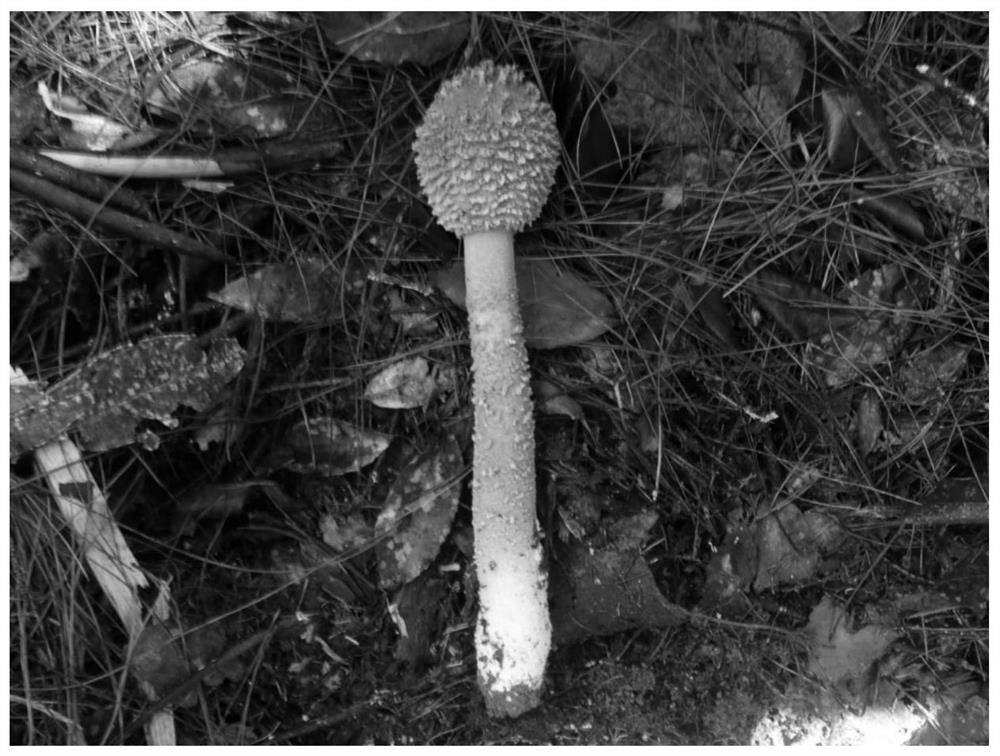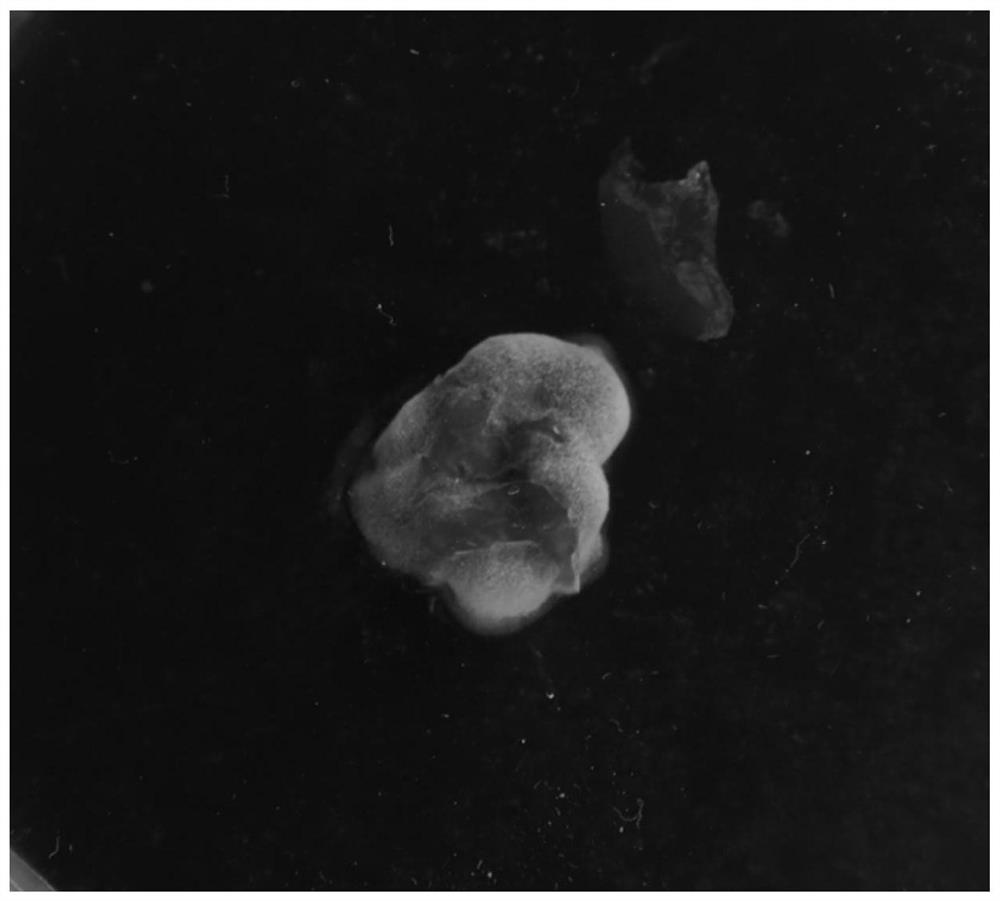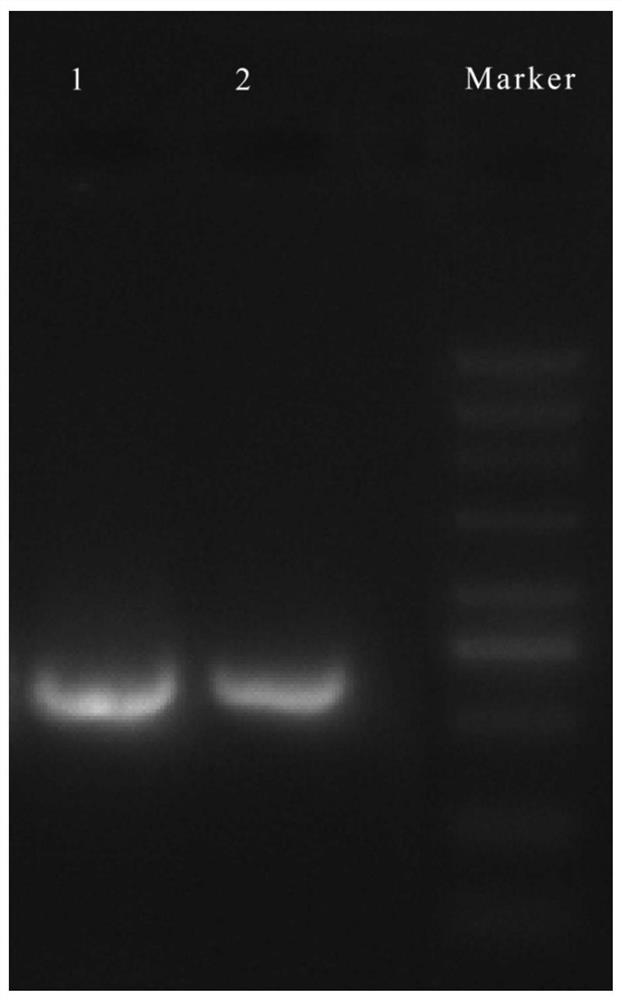Nucleic acid molecular primer, method and kit for identifying Chinese amanita
A nucleic acid molecule and amanita fungus technology, which is applied in the field of molecular biology methods for detecting edible fungi, can solve problems such as molecular identification reports that have not yet been found, and achieve the effects of good specificity and simple method.
- Summary
- Abstract
- Description
- Claims
- Application Information
AI Technical Summary
Problems solved by technology
Method used
Image
Examples
Embodiment 1
[0035] Example 1: Acquisition of Amanita sinensis strains
[0036] The fruiting bodies of Amanita sinensis, which grow vigorously and have not opened umbrellas, were collected from Fengkai County, Zhaoqing City, Guangdong Province (111°48'E, 23°55'N) (see figure 1 ), put it in the ice box and take it back to the laboratory on the same day, and immediately separate it in the ultra-clean workbench to obtain the tissue block for culture, the tissue block is 5×5mm. The cut tissue pieces were inoculated into plate medium, and the medium components were: PDA medium dry powder 40g / L, malt extract powder 8g / L, vitamin B1 60mg / L, myristate potassium salt 0.5mmol / L , yeast extract powder 2g / L. Inoculate 10 repeated plates and place them in a constant temperature incubator at 28°C for 2 months. It can be seen that gray-white colony structures are formed on the edges of tissue blocks in all culture dishes, with a diameter of about 2 cm (see figure 2 ). Scrape 20mg mycelia into 1.5ml c...
Embodiment 2
[0037] Embodiment 2: Amanita sinensis strain and fruiting body genome DNA extraction
[0038] DNA was extracted using the fast non-toxic plant DNA extraction kit (FHPlant DNA Kit) produced by Beijing Demantel Biotechnology Co., Ltd. First, add 100 μl of PL1 buffer solution to centrifuge tube 1 and centrifuge tube 2 respectively, and let stand at room temperature for 2 minutes. Then 600 μl of PL2 buffer was added, left at room temperature for 2 minutes, mixed up and down several times, and centrifuged at 10,000 rpm at room temperature for 30 seconds. Use a 200 μl pipette gun to transfer the supernatant to DNA adsorption columns 1 and 2 respectively, centrifuge at 10,000 rpm at room temperature for 1 minute, and discard the waste liquid. Add 300 μl of PL2 buffer to the adsorption column, centrifuge at 10,000 rpm for 1 minute at room temperature, and discard the waste liquid. Continue to add 600 μl of washing solution WB to the adsorption column, centrifuge at room temperature ...
Embodiment 3
[0039] Embodiment 3: the PCR amplification of Amanita sinensis specific primer
[0040]According to Amanita sinensis LG02.173 gene design specific primers LG02.173 F and LG02.173 R, LG02.173 F: CGATGACGATGACGACTC (as shown in SEQ ID NO.2) and LG02.173 R: ATTGGTGAGAGGCTTGGA (as shown in SEQ ID NO.3), the primer was synthesized by Shanghai Bioengineering Co., Ltd. The total volume of the reaction system is 50 μl: DNA template 1 μL, Taq DNA polymerase (5U / μL) 1 μL, upstream primer LG02.173 F (10 μmol / L) 1 μL, downstream primer LG02.173 R (10 μmol / L) 1 μL, 10×Buffer 5μL, 2mmol / L dNTP 5μL, 25mmol / L MgCl 2 3 μL, make up ddH 2 0 to 50 μL. The DNA templates were the fruiting bodies and hyphae DNA obtained in Example 2 (centrifuge tubes 3 and 4). The reaction program was: pre-denaturation at 94°C for 4 minutes; 35 cycles of denaturation at 94°C for 30 s, annealing at 56°C for 30 s, and extension at 72°C for 60 s; the final extension at 72°C for 10 min, and the product was stored a...
PUM
| Property | Measurement | Unit |
|---|---|---|
| diameter | aaaaa | aaaaa |
Abstract
Description
Claims
Application Information
 Login to View More
Login to View More - R&D
- Intellectual Property
- Life Sciences
- Materials
- Tech Scout
- Unparalleled Data Quality
- Higher Quality Content
- 60% Fewer Hallucinations
Browse by: Latest US Patents, China's latest patents, Technical Efficacy Thesaurus, Application Domain, Technology Topic, Popular Technical Reports.
© 2025 PatSnap. All rights reserved.Legal|Privacy policy|Modern Slavery Act Transparency Statement|Sitemap|About US| Contact US: help@patsnap.com



